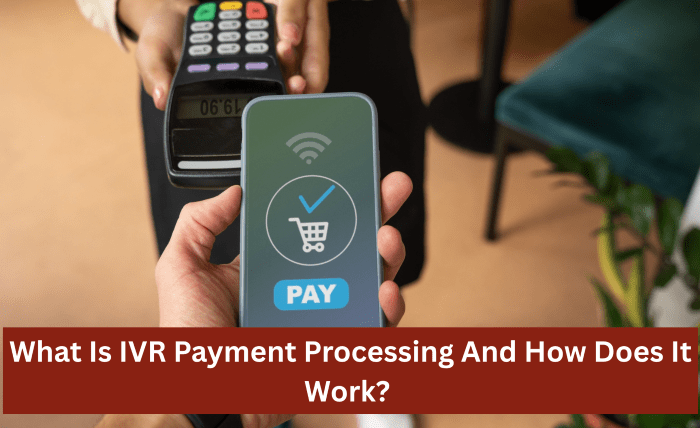
Accepting payments over the phone has changed in recent years.
Earlier, companies required full-time staff to sit and wait for the phone to ring, accept payment details, and enter every transaction manually into a computer. It was time-consuming, costly, and often created delays, especially during busy periods. It is easier now.
With the ever-developing technology, companies are now able to accept payments without face-to-face contact.
That’s where IVR payment processing comes in. It’s instant, secure, and hassle-free to get paid using a 24/7 automated phone system. Customers can call in at their convenience, follow easy-to-understand voice instructions, and complete their payment in just a few minutes. Businesses enjoy smooth, hassle-free transactions and never miss a payment opportunity.
With this in mind, this article explains what IVR payment processing is, how it is accomplished, and why many businesses are leveraging it to save money and time.

1. Understanding IVR Payment Processing
The IVR stands for Interactive Voice Response. The IVR is a system that allows a person to converse with an automated telephone system either vocally or by entering numbers on the phone’s keypad. This feature, when used for payments, enables customers to make secure payments over a phone call without needing to speak to an agent.
This is what it does in a nutshell. A customer calls a special telephone number. The system greets them and guides them step by step through the process to obtain the payment details. It prompts them to provide their details, such as account numbers or reference numbers, and then immediately processes the payment. The system is automated, so no personnel are required to get involved.
Companies utilize IVR payment processing to receive payments 24/7. It is like having a cashier who never has to take a break. The system can handle multiple calls simultaneously and is always ready to assist customers. Whether a small business or a big company, this type of system makes receiving payments easy, secure, and readily available.

2. How IVR Payment Processing Works?
IVR payment processing is a smart and convenient option. It utilizes telephony, security, and payment technologies to produce results on time.
Below is the sequence flow when a customer completes a payment.
When a customer dials, the IVR system answers within seconds. It welcomes the customer and provides simple instructions. A caller is guided with a series of verbal steps. For instance, the system instructions could say, “Please enter your customer number,” followed by “Please enter the amount you wish to pay.”
As a customer provides payment information, the system securely collects it. A technique known as DTMF masking is used. This means that when a customer inputs numbers, the corresponding tones are muted so that they cannot be overheard or recorded. This ensures that payment information is secured and complies with high security standards.
Upon gathering the requisite information, the IVR system dispatches a payment request to the integrated payment gateway, which works to complete payments in real-time. Additionally, the gateway validates the card information and tracks payment status updates in real-time.
Once payments are complete and successful, the system conveys a confirmation message to the customer. If a payment fails, the system will request that the payment be made again or offer an alternative payment method.
3. Why Businesses Use IVR Payment Systems?
Most companies nowadays utilize IVR payment solutions since they address several issues simultaneously. Processing payments manually takes time, money, and even poses risks at times. Automation changes things for the better, as it makes processes faster, cheaper, and safer.
One of the main reasons companies opt for IVR payment processing is to cut costs. Paying automatically enables fewer employees to operate the phones. That can reduce operating expenses up to 70 percent. The funds saved can then be allocated to other areas of the company.
Another benefit is availability. Customers today desire easy payment terms. Some prefer to pay online, while others appreciate the convenience of a phone call. With a computerized IVR system, businesses can cater to both. Payments are possible at any time, including outside business hours, providing customers with maximum convenience.
Security is another very important feature. IVR payment systems adhere to the highest standards of payment data security, including PCI-DSS Level 1 compliance. Sensitive data never passes through human hands, thereby reducing the risk of data exposure or error.
4. Benefits of IVR Payment Processing
The IVR payment processing benefits both parties in the transaction. To businesses, it means lower costs, higher efficiency, and less human intervention. To customers, it means greater freedom and faster service.
On the business side, one of the greatest benefits is the ability to operate around the clock. Payments can be accepted at any time — even outside of office hours, on weekends, or during holidays. That’s particularly helpful for businesses with clients in other time zones or those that involve urgent payments.
Quick cash flow is another benefit. As payments are cleared in real-time, businesses no longer need to wait for manual reconciliation and confirmation. Money moves faster, which helps ensure seamless operations.
The system also introduces scalability. As a business expands, it can manage more customers without requiring additional personnel. IVR systems can also process multiple payments simultaneously, allowing businesses to manage peak periods more efficiently.
6. Features of IVR Payments
IVR payment solutions are designed with a range of cutting-edge features to make them efficient and reliable. Every component is designed to provide customers with a trouble-free and seamless experience while protecting their personal information.
The first of these is secure capture of information. Using DTMF masking, the system ensures that no one can hear or record the tones of the customer’s key during the payment process. This ensures that all transactions are completely confidential and meet all security standards.
Another key feature is real-time processing of payments. Payment information is never stored in the system and processed as a whole. After a customer completes payment authorization, it is posted directly through the payment gateway, and approval is reflected to the business and customer in a matter of seconds.
Database integration is also a very important feature. The IVR system integrates directly with the company’s internal systems. It updates itself automatically, creates invoices, sends confirmation messages, and logs the transaction to report after successful payment processing. It doesn’t need to be updated manually because it saves time and reduces errors.
Final Thought
IVR payment processing is revolutionizing the way businesses make payments. It’s secure, fast, and accessible at all times. With automatic systems, customers can make payments at their convenience, and businesses can receive payments without requiring employees to answer every call.
The process is easy: customers call, follow the voice instructions, input their payment details, and receive instant verification. Everything is done automatically and securely. Businesses save money, improve their cash flow, and provide a better customer experience.




